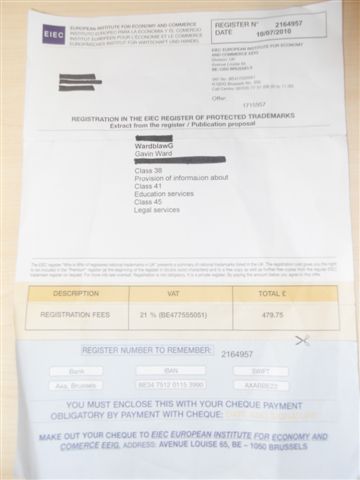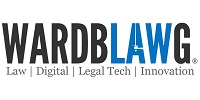Trade Marks
Third, if you have not already done so, apply for at least one trade mark to your national intellectual property office.
In the UK, this is the UK IPO;
In America it is the USPTO;
In Europe for Community Trade Marks (CTMs), it is the OHIM.
OHIM, Cybersquatting and the Art of WardblawG
In passing, OHIM.com is cybersquatted: how ironic!: the official trade mark site for Europe doesn’t have its proper domain name, which is a testament to the dog-eat-dog nature of the web with little practical control. Obiter, I’m a big fan of the book and blog BabyBarista and the Art of War. Sun Tzu and the Art of WardblawG might follow, or maybe How to make Blawgs and Influence People? Afterall, commercialisation of IP is the bread and butter of the IP lawyer.
OHIM not EIEC for European Community Trade Marks
Note that the European trade mark registry is NOT the EIEC, which managed to “earn” several thousand pounds from a good entrepreneurial business friend of mine, and which, despite having no apparent official or valid purpose, still manages not to represent itself properly and which had the cheek to send an invitation to me asking for almost £500 to be paid to the EIEC to do hardly anything, after my trademark application was published in the UK IPO TM Journal back in July.
If you ever get a letter that looks like the one below, best advice is to destroy it immediately. To view the following image in a more user-friendly manner, please either right click to save, or left click:

EIEC, thanks for pretending that you can offer trademark protection throughout the EC, while having business managers hit themselves on the face when they realise, after paying your invoices without reading your small print, that they still have to apply to the official trade mark register in the EC for actual legal protection. From a Google search, “EIEC is a scam” is a pretty common listing.
See, for instance, a full, comprehensive list of trade mark scams, old and new, from Lisa Lennon of Gilbert + Tobin. See also an online prominent warning against EIEC’s “business”.
UK trade mark application
To apply for a trademark in the UK, you need to submit your application to the UK IPO. They accept electronic submissions now which are highly recommended. The time it takes you to prepare the application really does depend on your business. For me, it took about an hour, principally because I knew how to do it already, following fellow blawger Professor Jeremy Phillips’s example with his IPKat registration, for which he used Olswang solicitors. The official fee was £300: £250 for 2 classes, plus £50 for one additional class. The expressions web log and blog were used. Afterall, you might as well protect yourself in those most relevant of classes of products or services. For more complex or unique businesses, professional trade mark agents or “attorneys” as they are sometimes known, are recommended. Marc Lieberstein now of Kilpatrick Stockton LLP here is to be recommended highly in the States. Williams Powell including, in particular, John Reddington is to be recommended highly in the UK.
See the IPKat’s UK trade mark registration and WardblawG’s UK trade mark application for further inspiration and ideas.
Key Message
If you take one thing away from this, it should be this practical but general word of advice:
If your business and its model are analogous to another successful and well-protected business and if your brand name is unique, not in the dictionary, not an industry word and not confusingly similar to another business, then take inspiration from the trade mark applications of that other successful business, but do consider every application on its own merits; and
If you are in any doubt about trade mark registrability, research further or seek professional advice from a lawyer, brand protector or trade mark agent. In my experience, trade mark agents are most useful when registrability of your brand as a trade mark is clearly problematic, when you need to overcome objections or field queries from an examiner, or when you have a large portfolio of trade marks to register and maintain.
The next chapters
Chapter 4 on Copyright and Chapter 5 on Creatives Commons Licences will follow shortly…




